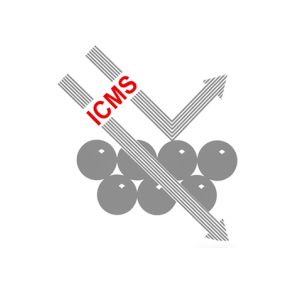Scientific Papers in SCI
2010
2010
Fotocatálisis Heterogénea: Aplicaciones
Gas phase photocatalytic oxidation of toluene using highly active Pt doped TiO2
Colon, G; Maicu, M; Hidalgo, MC; Navio, JA; Kubacka, A; Fernandez-Garcia, MJournal of Molecular Catalysis A-Chemical, 320 (2010) 14-18 DOI: 10.1016/j.molcata.2009.12.009

Abstract
Platinum doped TiO2 materials were studied for the gas phase photocatalytic degradation of toluene. Platinum deposition was achieved by photodeposition method over TiO2 prepared by means of a sol-gel route. The effect of sulphuric acid pretreatment on the further platinisation process has been extensively studied. From the wide structural and surface analysis of the catalysts an interesting synergetic effect has been demonstrated. The previous sulphate treatment over TiO2 leads to improved dispersion of the Pt which presents a lower aggregation and homogeneous cluster size. This fact, together with the adequate control of anatase structural and surface parameter due to the sulphate treatment, renders a good photocatalytic performance for toluene oxidation reaction. The highest reaction rates and CO2 selectivities have been obtained for Pt-S-TiO2 samples.
April, 2010 · DOI: 10.1016/j.molcata.2009.12.009
Materiales Avanzados
Physical and geotechnical properties of clay phyllites
Garzon, E; Sanchez-Soto, PJ; Romero, EApplied Clay Science, 48 (2010) 307-318 DOI: 10.1016/j.clay.2009.12.022
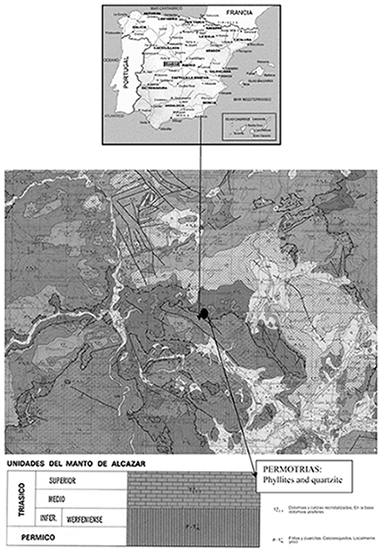
Abstract
An experimental programme is presented with the aim of characterising - from physical, microstructural and geotechnical perspectives - the main properties of compacted clay phyllites. These clay phyllites are widely used as waterproofing material for roofs in the Alpujarra (Andalusia, Spain), as sealing liners in irrigation ponds, and as core material of small earthen zoned dams. An exhaustive physical-characterisation programme on the powder fraction has been followed using X-ray fluorescence (XRF), X-ray diffraction (XRD), transmission electron microscopy (TEM), scanning electron microscopy (SEM), chemical analysis by energy dispersive X-ray spectroscopy (EDX), thermal analysis, particle-size distribution analysis, consistency limits, and density of solid particles. From a microstructural standpoint, mercury intrusion porosimetry (MIP) tests, as well as nitrogen-adsorption tests, were carried out to characterise the pore network and surface area of the material in both natural and compacted states. The geotechnical characterisation programme on the compacted material was focused on the water-permeability and water-retention properties, the volume change on soaking (swelling or collapse), the compressibility on loading, the shear-strength properties, and the mechanical-penetration properties. In this way, an important physical and hydro-mechanical data base is provided, which could help in evaluating the suitability for using this material in a wide range of earthen constructions (liners, road subgrades, embankments, core material in zoned dams). It has been found that the material contains illite, chlorite and quartz as the main components, and feldspar, iron oxide and interstratified illite-smectite as minor ones. Despite the presence of active clay minerals, the compacted material did not display an important swelling on soaking at low stresses, as a consequence of its low specific surface and low water-retention ability. The material exhibited good compaction properties and, consequently, low water permeability plus a stiff response on loading. Nevertheless, despite the low porosity attained on the dry-side compaction, the material underwent some collapse on soaking at stresses greater than 100 kPa.
April, 2010 · DOI: 10.1016/j.clay.2009.12.022
Determination of pigments and binders in Pompeian wall paintings using synchrotron radiation - High-resolution X-ray powder diffraction and conventional spectroscopy-chromatography
Duran, A; De Haro, MCJ; Perez-Rodriguez, JL; Franquelo, ML; Herrera, LK; Justo, AArchaeometry, 52 (2010) 286-307 DOI: 10.1111/j.1475-4754.2009.00478.x
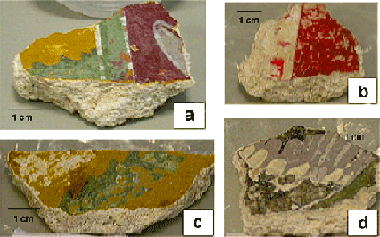
Abstract
The employment of synchrotron techniques complemented by conventional laboratory systems has allowed us to deepen and improve our knowledge of Roman wall painting procedures. The palette identified in wall paintings from Pompeii and Herculaneum from the second century bc includes goethite, hematite, cinnabar, glauconite, Egyptian blue, and other components such as calcite and aragonite. Proof of the use of organic binders is provided by FTIR and PY-GC/MS. Therefore, the possibility of the use of 'a secco' techniques cannot be ruled out. Pigments in wall paintings are usually found in small percentages and conventional X-ray diffractometers do not detect them. Synchrotron radiation - high-resolution X-ray powder diffraction has allowed identification with only a few micrograms of sample.
April, 2010 · DOI: 10.1111/j.1475-4754.2009.00478.x
Nanotecnología en Superficies y Plasma
Surface Functionalization, Oxygen Depth Profiles, and Wetting Behavior of PET Treated with Different Nitrogen Plasmas
Lopez-Santos, C; Yubero, F; Cotrino, J; Gonzalez-Elipe, ARACS Applied Materials & Interfaces, 2 (2010) 980-990 DOI: 10.1021/am100052w
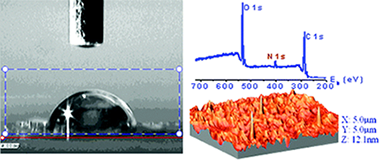
Abstract
Polyethylene terephthalate (PET) plates have been exposed to different nitrogen containing plasmas with the purpose of incorporating nitrogen functional groups on its surface. Results with a dielectric barrier discharge (DBD) at atmospheric pressure and a microwave discharge (MW) at reduced pressure and those using an atom source working under ultrahigh vacuum conditions have been compared for N-2 and mixtures Ar + NH3 as plasma gases. The functional groups have been monitored by X-ray Photoemission Spectroscopy (XPS). Nondestructive oxygen and carbon depth profiles for the plasma treated and one month aged samples have been determined by means of the nondestructive Tougaard's method of XPS background analysis. The surface topography of the treated samples has been examined by Atomic Force Microscopy (AFM), while the surface tension has been determined by measuring the static contact angles of water and iodomethane. It has been found that the DBD with a mixture of Ar+NH3 is the most efficient treatment for nitrogen and amine group functionalization as determined by derivatization by reaction with chlorobenzaldehyde. It is also realized that the nitrogen functional groups do not contribute significantly to the observed increase in surface tension of plasma treated PET.
April, 2010 · DOI: 10.1021/am100052w
Materiales de Diseño para la Energía y Medioambiente
Structural characterization of polyhydroxy fatty acid nanoparticles related to plant lipid biopolyesters
Heredia-Guerrero, JA; Dominguez, E; Luna, M; Benitez, JJ; Heredia, AChemistry and Physics of Lipids, 163 (2010) 329-333 DOI: 10.1016/j.chemphyslip.2010.01.006
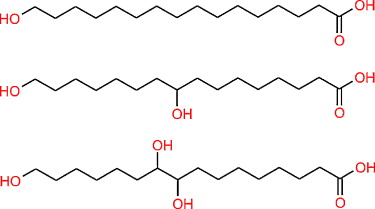
Abstract
In the present work, we report the physico-chemical properties and structural characteristics of special polyhydroxy fatty acid nanoparticles after their fusion by means of attenuated total reflection-Fourier transform infrared spectroscopy (ATR-FTIR), X-ray diffraction (XRD), differential scanning calorimetry (DSC), scanning electronic microscopy (SEM), atomic force microscopy (AFM), and light microscopy. All the characteristics and properties investigated have an important degree of similarity to the native plant cutin, the main biopolymer present in the plant cuticles. The supramolecular organization of these polymerized prime nanoparticles after their interaction on cellulose substrate and isolated cuticle samples, simulating the in vivo conditions in epidermal plant cells, strongly suggests a growth of these nanoparticles after a self-assembly process.
March, 2010 · DOI: 10.1016/j.chemphyslip.2010.01.006
Materiales Ópticos Multifuncionales
Theoretical Analysis of the Performance of One-Dimensional Photonic Crystal-Based Dye-Sensitized Solar Cells
Lozano, G; Colodrero, S; Caulier, O; Calvo, ME; Miguez, HJournal of Physical Chemistry C, 114 (2010) 3681-3687 DOI: 10.1021/jp9096315
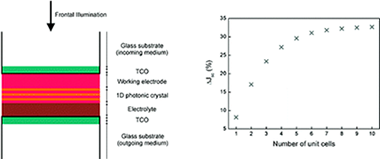
Abstract
A simple analytical model that allows designing one-dimensional photonic crystal based dye sensitized solar cells of optimized performance, accounting for the actual optical features of the device, is herein presented. Based on the theoretical description of the effect of coupling such Bragg mirrors to the light harvesting electrode, recently reported experimental values of the spectral dependence of incident photon to current conversion efficiency attained for such Structures are fairly reproduced and rationalized. A thorough analysis or them in terms of the interplay between the effect of the electrode thickness and the characteristics of the Bragg reflection, such as intensity, spectral position, and width, is provided. Predictions on the maximum enhancement factors expected for realistic Structures are also presented.
March, 2010 · DOI: 10.1021/jp9096315
A thermal study approach to roman age wall painting mortars
Duran, A; Perez-Maqueda, LA; Poyato, J; Perez-Rodriguez, JLJournal of Thermal Analysis and Calorimetry, 99 (2010) 803-809 DOI: 10.1007/s10973-009-0667-2
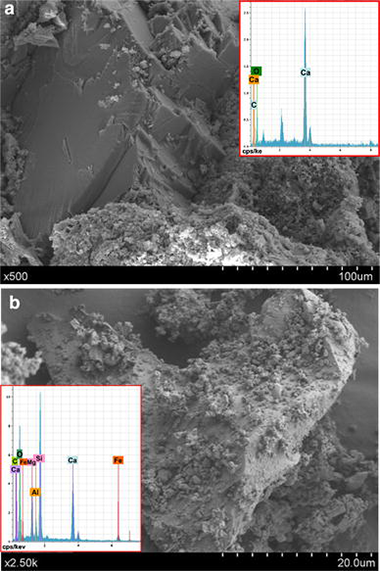
Abstract
Roman ancient mortars have been widely studied, in connection with both diagnosis and application required for restoring. Thermoanalytical experiments performed on mortars from Pompeii and Herculaneum provided a very good understanding of the technology employed. The mortars from Pompeii were obtained by the proper mixing of lime and marble grains while mortars of Herculaneum by lime and silicates compounds. The position of the endothermic peak of calcite decomposition showed important variations in the different samples studied, which was assigned to the different crystallinity and particle sizes. Experiments under CO2 flow confirmed the presence of magnesium calcium carbonates.
March, 2010 · DOI: 10.1007/s10973-009-0667-2
Materiales y Procesos Catalíticos de Interés Ambiental y Energético
Room-Temperature Reaction of Oxygen with Gold: An In situ Ambient-Pressure X-ray Photoelectron Spectroscopy Investigation
Jiang, P; Porsgaard, S; Borondics, F; Kober, M; Caballero, A; Bluhm, H; Besenbacher, F; Salmeron, MJournal of the American Chemical Society, 132 (2010) 2858-2859 DOI: 10.1021/ja909987j

Abstract
The interaction of O-2 with gold foil and gold nanoparticles grown by thermal deposition on TiO2(110) was studied by in situ ambient pressure X-ray photoelectron spectroscopy at room temperature. No spontaneous dissociation of O-2 was observed either on Au foil or oil Au nanoparticles up to 1 Torr of O-2. X-ray irradiation, however, is very effective in promoting gold oxidation on both surfaces in the presence of O-2. Our results help reconcile recent conflicting experimental observations regarding the activation of molecular oxygen, which is a crucial issue in Au catalyzed oxidation reactions.
March, 2010 · DOI: 10.1021/ja909987j
Reactividad de Sólidos
Microstructural characterization of copper based alloys produced by reactive milling
Palma, R; Sepulveda, A; Zuniga, A; Donoso, E; Dianez, MJ; Criado, JMRevista de Metalurgia, 46 (1010) 197-205 DOI: 10.3989/revmetalm.2010.v46.i3
Abstract
The micro and nanostructure of Cu-Al, Cu-V and Cu-Ti alloys produced by reactive milling were analyzed using X-ray diffraction (XRD) and transmission electron microscopy (TEM). Samples with different milling times (t = 0, 10, 20 and 30 h) were considered. The grain size, dislocation density and residual microstrain were evaluated form the XRD data using the Williamson-Hall and Klug-Alexander methods. The evolution of texture as a function of milling time was also studied using XRD. It was found, using TEM, that the grain size and dispersoid size were nanometric in all three alloys considered.
March, 2010 · DOI: 10.3989/revmetalm.2010.v46.i3
Nanotecnología en Superficies y Plasma
Evaluation of Different Dielectric Barrier Discharge Plasma Configurations As an Alternative Technology for Green C-1 Chemistry in the Carbon Dioxide Reforming of Methane and the Direct Decomposition of Methanol
Rico, VJ; Hueso, JL; Cotrino, J; Gonzalez-Elipe, ARJournal of Physical Chemistry A, 114 (2010) 4009-4016 DOI: 10.1021/jp100346q
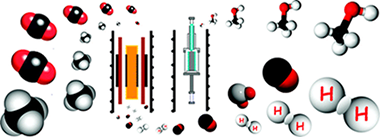
Abstract
Carbon dioxide reforming of methane and direct decomposition of methanol have been investigated using dielectric harrier discharges (DBD)) at atmospheric pressure and reduced working temperatures. Two different plasma reactor configurations are compared and especial attention is paid to the influence of the surface roughness of the electrodes oil the conversion yields in the first plasma device. The influence of different filling gap dielectric materials (i.e., Al2O3 of BaTiO3) in the second packed configuration has been also evaluated. Depending on the experimental conditions of applied voltage, residence time of reactants. feed ratios, or factor configuration. different conversion yields are achieved ranging front 20 to 80% in the case of methane and 7-45% for the carbon dioxide. The direct decomposition of methanol reaches 60-100% Under similar experimental conditions. Interestingly, the selectivity toward the production of hydrogen and carbon monoxide is kept almost constant under all the experimental conditions, and the formation of longer hydrocarbon chains of coke is a byproduct is not detected. The maximum efficiency yields are observed for the packed-bed reactor configuration containing alumina for both reaction processes (similar to 1 mol H-2 per kilowatt hour for dry reforming of methane and similar to 4.5 mol H-2, per kilowatt hour for direct decomposition of methanol).
March, 2010 · DOI: 10.1021/jp100346q
Materiales de Diseño para la Energía y Medioambiente
Application of Micro-X-ray Fluorescence Analysis for the Characterization of Industrial Wastes
Alba, MD; Aparicio, P; Benitez, JM; Castro, MA; Diaz, M; Orta, MMIndustrial & Engineering Chemistry Research, 49 (2010) 2348-2352 DOI: 10.1021/ie901716w
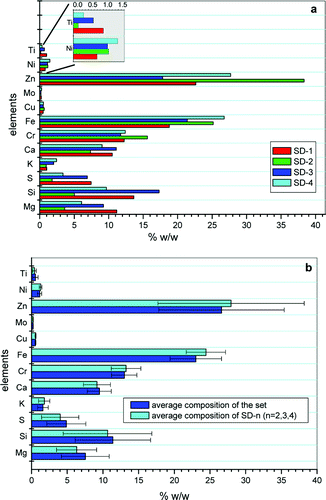
Abstract
The issue of how to improve product quality and product yield in a short period of time is becoming more critical in many industries. Thus, shorter delay times between laboratory analysis and process correction are important in process control. Elimination of sample handling and operator Manipulation is desirable. The present article proposes micro-X-ray fluorescence (mu XRF) as an economical control method for industrial product quality with a minimum time cost. Samples from different industrial processes have been chosen and analyzed by XRF and mu XRF, The results show that the two techniques give similar results and that mu XRF allows the waste to be classified and is able to detect problems in the production process.
March, 2010 · DOI: 10.1021/ie901716w
Materiales Nanoestructurados y Microestructura
Magnetometry and electron paramagnetic resonance studies of phosphine- and thiol-capped gold nanoparticles
Guerrero, E; Munoz-Marquez, MA; Fernandez, A; Crespo, P; Hernando, A; Lucena, R; Conesa, JCJournal of Applied Physics, 107 (2010) 064303-064309 DOI: 10.1063/1.3327414

Abstract
In the last years, the number of studies performed by wholly independent research groups that confirm the permanent magnetism, first observed in our research lab, for thiol-capped Au nanoparticles (NPs) has rapidly increased. Throughout the years, the initial magnetometry studies have been completed with element-specific magnetization measurements based on, for example, the x-ray magnetic circular dichroism technique that have allowed the identification of gold as the magnetic moment carrier. In the research work here presented, we have focused our efforts in the evaluation of the magnetic behavior and iron impurities content in the synthesized samples by means of superconducting quantum interference device magnetometry and electron paramagnetic resonance spectrometry, respectively. As a result, hysteresis cycles typical of a ferromagnetic material have been measured from nominally iron-free gold NPs protected with thiol, phosphine, and chlorine ligands. It is also observed that for samples containing both, capped gold NPs and highly diluted iron concentrations, the magnetic behavior of the NPs is not affected by the presence of paramagnetic iron impurities. The hysteresis cycles reported for phosphine-chlorine-capped gold NPs confirm that the magnetic behavior is not exclusively for the metal-thiol system.
March, 2010 · DOI: 10.1063/1.3327414
Reactividad de Sólidos
Mechanosynthesis of Hf1-xZrxB2 Solid Solution and Hf1-xZrxB2/SiC Composite Powders
Aviles, MA; Cordoba, JM; Sayagues, MJ; Alcala, MD; Gotor, FJJournal of the American Ceramic Society, 93 (2010) 696-702 DOI: 10.1111/j.1551-2916.2009.03484.x
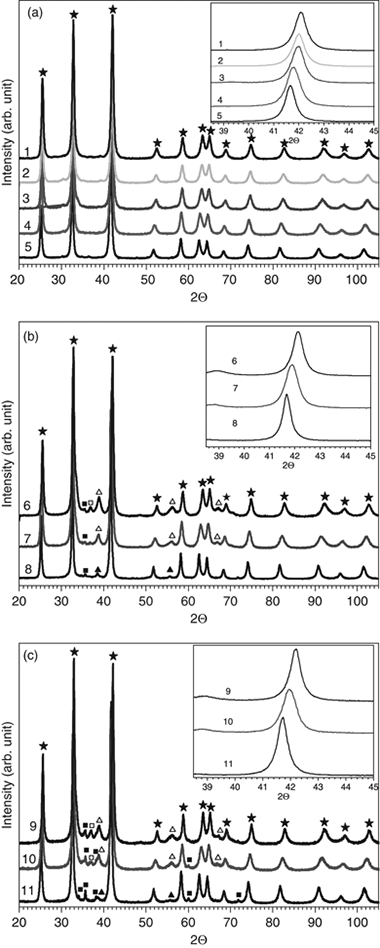
Abstract
The synthesis of solid solutions in the HfB2-ZrB2 system was conducted by mechanically induced self-sustaining reaction (MSR) processes under an inert atmosphere from elemental mixtures of Hf, Zr, and B. The stoichiometry of the Hf1-xZrxB2 solid solution phase was controlled by adjusting the Hf/Zr/B atomic ratio in the starting mixture. Composite materials with SiC were achieved by adding the required amount of SiC to the Hf/Zr/B reactant mixture. The presence of up to 20 vol% of SiC did not inhibit the MSR process. Longer milling times were required to ignite the mixture. Small amounts of the refractory phases ZrC or HfC were observed in the composite powders. The chemical composition, structure, and microstructure of products were studied by X-ray diffraction, scanning and transmission electron microscopy, electron diffraction, and energy-dispersive X-ray spectroscopy. This complete characterization confirmed the formation of P6/mmm hexagonal diboride phases with a submicrometric microstructure. The determination of the chemical composition and lattice parameters ascertained the formation of solid solutions with good chemical homogeneity in the HfB2-ZrB2 system.
March, 2010 · DOI: 10.1111/j.1551-2916.2009.03484.x
Nanotecnología en Superficies y Plasma
Active and Optically Transparent Tetracationic Porphyrin/TiO2 Composite Thin Films
Castillero, P; Sanchez-Valencia, JR; Cano, M; Pedrosa, JM; Roales, J; Barranco, A; Gonzalez-Elipe, ARACS Applied Materials & Interfaces, 2 (2010) 712-721 DOI: 10.1021/am900746q
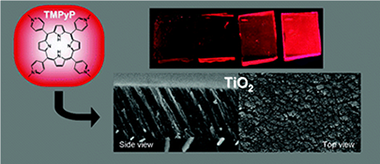
Abstract
Fluorescent tetracationic porphyrin (TMPyP) molecules have been incorporated into optically transparent TiO2 thin films acting as a host material. The films, with a columnar structure and open pores, were prepared by electron evaporation at glancing angles (GAPVD). The open porosity of the films has been estimated by measuring a water adsorption isotherm with a quartz crystal monitor. TMPyP molecules were infiltrated in the host thin films by their immersion into water solutions at controlled values of pH. The state of the adsorbed molecules, the infiltration efficiency, and the adsorption kinetics were assessed by analyzing the optical response of the films by UV-vis absorption and fluorescence techniques. The infiltration efficiency was directly correlated with the acidity of the medium, increasing at basic pHs as expected from simple considerations based on the concepts of the point of zero charge (PZC) developed for colloidal oxides. By a quantitative evaluation based on the analysis of the UV spectra, the infiltration process has been described by a Langmuir type adsorption isotherm and an Elovich-like kinetics. The accessibility of the infiltrated molecules in the TMPyP/TiO2 composite films is assessed by following the changes of their optical properties when exposed to the acid vapors and their subsequent recovery with time.
March, 2010 · DOI: 10.1021/am900746q
Reactividad de Sólidos
Spark Plasma Sintering of Ultrafine TiCxN1-x Powders Synthesized by a Mechanically Induced Self-Sustaining Reaction
Borrell, A; Fernandez, A; Torrecillas, R; Cordoba, JM; Aviles, MA; Gotor, FJJournal of the American Ceramic Society, 93 (2010) 2252-2256 DOI: 10.1111/j.1551-2916.2010.03735.x
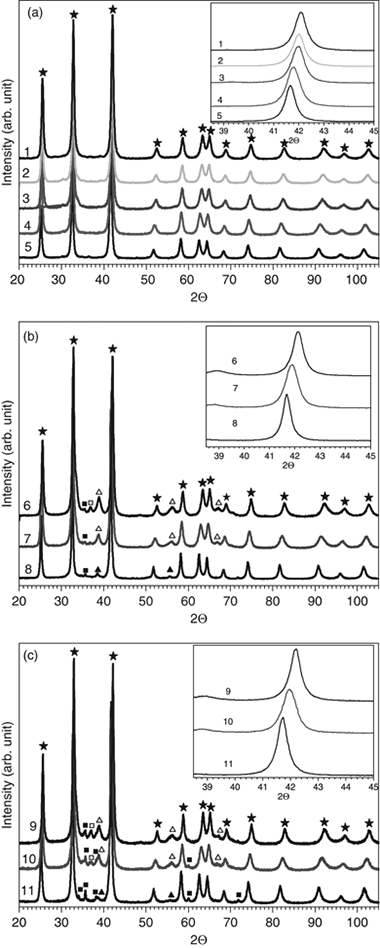
Abstract
High-purity, nanometer-sized titanium carbonitride powders, TiCxN1-x, were obtained with a mechanically induced self-sustaining reaction (MSR) in a high-energy planetary ball mill from a mixture of titanium and different carbon precursors under a nitrogen atmosphere. A promising method for developing dense TiCxN1-x materials is the coupling of MSR with the spark plasma sintering (SPS) technique. The powders were sintered at different temperatures to provide a completely dense monolithic ceramic (> 99% theoretical density). In this work, the influence of the carbon precursor and SPS treatment on the material microstructures were studied, and the main mechanical properties of the end material were evaluated.
March, 2010 · DOI: 10.1111/j.1551-2916.2010.03735.x
Nanotecnología en Superficies y Plasma
Morphological evolution of pulsed laser deposited ZrO2 thin films
Alvarez, R; Palmero, A; Prieto-Lopez, LO; Yubero, F; Cotrino, J; de la Cruz, W; Rudolph, H; Habraken, FHPM; Gonzalez-Elipe, ARJournal of Applied Physics, 107 (2010) 54311-54320 DOI: 10.1063/1.3318604
Abstract
Morphological evolution of ZrO2 thin films deposited during pulsed laser deposition of Zr in O-2 atmosphere has been experimentally studied at two different film deposition temperatures, 300 and 873 K. The roughness exponent, alpha, the growth exponent, beta, the coarsening exponent, 1/z, and the exponent defining the evolution of the characteristic wavelength of the surface, p, for depositions at 300 K amounted to beta = 1.0 +/- 0.1, alpha = 0.4 +/- 0.1, 1/z = 0.34 +/- 0.03, and p = 0.49 +/- 0.03, whereas for depositions carried out at 873 K amounted to beta = 0.3 +/- 0.3, alpha = 0.4 +/- 0.2, and 1/z = 0.0 +/- 0.2. Experimental error becomes important due to the flat morphology of the films inherent to the deposition technique. The change in the surface topography with the film temperature has been studied with the help of a simple Monte Carlo model which indicates the existence of two different growth regimes: a shadowing dominated growth, occurring at low temperatures, characterized by calculated values beta = 1.00 +/- 0.04, alpha = 0.50 +/- 0.04, p = 0.46 +/- 0.01, and 1/z = 0.35 +/- 0.02 and a diffusion dominated growth that takes place at high temperatures as well as at low deposition rates, characterized by calculated values beta = 0.15 +/- 0.08, alpha = 0.33 +/- 0.04, and 1/z = 0.33 +/- 0.07. The good agreement obtained between the experimental and simulated parameters is discussed within the frame of the general characteristics of the deposition method.
March, 2010 · DOI: 10.1063/1.3318604
Seville City Hall Chapter Room ceiling decoration
Duran, A; Robador, MD; de Haro, MCJ; Herrera, LK; Gimena, P; Perez-Rodriguez, JLMateriales de Construcción, 60 (2010) 83-95 DOI: 10.3989/mc.2010.45107
Abstract
El objetivo de este trabajo es el estudio de diferentes aspectos, como el color, la composición química y las fases mineralógicas presentes en los diferentes materiales que forman la ornamentación del techo de la Sala Capitular del Ayuntamiento de Sevilla, mediante métodos físicos y químicos. Nuestros resultados muestran que el dorado fue realizado sobre una capa de bol previamente depositada sobre una lámina de blanco de plomo que cubría un estrato de calcita. Posteriormente, y probablemente debido a alteraciones en el dorado original, el techo fue de nuevo dorado usando una técnica similar. En el siglo XIX, casi todo el techo, excepto las zonas con inscripciones, fue blanqueado usando una mezcla de calcita y blanco de plomo. Se empleó plata para cubrir la espada del rey Juan I (casetón 27). Finísimas láminas de oro se usaron para decorar los atributos reales: coronas, cinturones, cetros, espadas y rosarios. En diferentes partes de la decoración fueron detectados pigmentos como azurita, malaquita, bermellón y negro de humo. La composición del mortero de la estructura era a base de cal y dolomita molida.
February, 2010 · DOI: 10.3989/mc.2010.45107
Materiales y Procesos Catalíticos de Interés Ambiental y Energético
In situ spectroscopic detection of SMSI effect in a Ni/CeO2 system: hydrogen-induced burial and dig out of metallic nickel
Caballero, A; Holgado, JP; Gonzalez-delaCruz, VM; Habas, SE; Herranz, T; Salmeron, MChemical Communications, 46 (2010) 1097-1099 DOI: 10.1039/b920803h
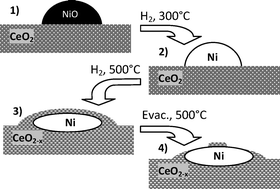
Abstract
In situ APPES technique demonstrates that the strong metal support interaction effect (SMSI) in the Ni-ceria system is associated with the decoration and burial of metallic particles by the partially reduced support, a phenomenon reversible by evacuation at high temperature of the previously absorbed hydrogen.
February, 2010 · DOI: 10.1039/b920803h
Materiales Nanoestructurados y Microestructura
Oxidation State and Local Structure of Ti-Based Additives in the Reactive Hydride Composite 2LiBH(4) + MgH2
Deprez, E; Muñoz-Marquez, MA; Roldan, MA; Prestipino, C; Palomares, FJ; Minella, CB; Bosenberg, U; Dornheim, M; Bormann, R; Fernandez, AJournal of Physical Chemistry C, 114 (2010) 3309-3317 DOI: 10.1021/jp910955r
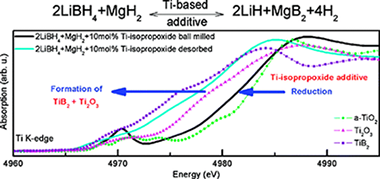
Abstract
Nowadays, the technological utilization of reactive hydride composites (RHC) Lis hydrogen storage materials is limited by their reaction kinetics. However, addition of transition-metal-based additives, for instance titanium isopropoxide (Ti-iso), to the 2LiBH(4)+MgH2 system, results in a significant improvement of sorption kinetics. In this work, the evolution of chemical state and local structure of the Ti-based additive has been investigated by means of X-ray absorption (XAS) and photoemission (XPS) spectroscopy. X-ray absorption near-edge Structure (XANES) its well as extended X-ray absorption fine structure (EXAFS) analysis have been Undertaken at the Ti K-edge. The measurements reveal the formation of a highly dispersed and disordered TiO2-like phase during ball milling. During first desorption reduced titanium oxide and titanium boride are formed and remain stable upon cycling. The Surface analysis performed by XPS shows that the reduction processes of the Ti-based additive during first desorption IS Coupled to the migration of the Ti species front the surface to the bulk of the material. Several factors, related to favoring heterogeneous nucleation of MgB2 and the increase of interfacial area through grain refinement are proposed as potential driving force, among other effects, for the observed kinetic improvement.
February, 2010 · DOI: 10.1021/jp910955r
Materiales de Diseño para la Energía y Medioambiente
Lanthanide sorption on smectitic clays in presence of cement leachates
Galunin, E; Alba, MD; Santos, MJ; Abrao, T; Vidal, MGeochimica et Cosmochimica Acta, 74 (2010) 862-875 DOI: 10.1016/j.gca.2009.11.003
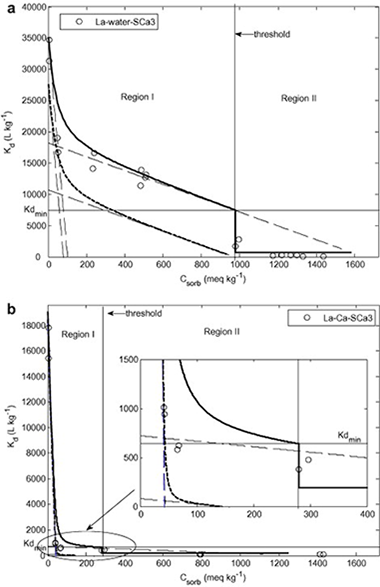
Abstract
Due to their potential retention capacity, clay minerals have been proposed for use in the engineered barriers for the storage of high-level radioactive actinides in deep geological waste repositories. However, there is still a lack of data on the sorption of actinides in clays in conditions simulating those of the repositories. The present article examines the sorption of two lanthanides (actinide analogues) in a set of smectitic clays (FEBEX bentonite, MX80 bentonite, hectorite, saponite, Otay montmorillonite, and Texas montmorillonite). Distribution coefficients (K-d) were determined in two media: water and 0.02 mol L-1 Ca, the latter representing the cement leachates that may modify the chemical composition of the water in contact with the clay. The K-d values of the lanthanides used in the experiments (La and Lu) varied greatly (25-50 000 L kg(-1)) depending on the ionic medium (higher values in water than in the Ca medium), the initial lanthanide concentration (up to three orders of magnitude decrease inversely with lanthanide concentration), and the examined clay (up to one order of magnitude for the same lanthanide and sorption medium). Freundlich and Langmuir isotherms were used to fit sorption data to allow comparison of the sorption parameters among smectites. The model based on the two-site Langmuir isotherms provided the best fit of the sorption data, confirming the existence of sorption sites with different binding energies. The sites with higher sorption affinity were about 6% of the total sorption capacity in the water medium, and up to 17% in the Ca medium, although in this latter site sorption selectivity was lower. The wide range of K-d values obtained regarding the factors examined indicated that the retention properties of the clays should also be considered when selecting a suitable clay for engineered barriers.
February, 2010 · DOI: 10.1016/j.gca.2009.11.003
Nanotecnología en Superficies y Plasma
Air- and Light-Stable Superhydrophobic Colored Surfaces Based on Supported Organic Nanowires
Borras, A; Groning, P; Sanchez-Valencia, JR; Barranco, A; Espinos, JP; Gonzalez-Elipe, ARLangmuir, 26 (2010) 1487-1492 DOI: 10.1021/la903701j

Abstract
In this work, we report oil it new type of superhydrophobic material consisting of supported organic nanowires prepared by vacuum deposition, Different intensely colored surfaces with water contact angles its high its 180 degrees call be Fabricated depending oil the composition. morphology, and density of the nanowires. These surfaces are stable in air and under intense light irradiation. The wettability properties of coatings made of metalloporphyrins and metallophthalocyanines nanowires as well as other heterostructured binary and open core@shell nanowires are studied.
February, 2010 · DOI: 10.1021/la903701j
Materiales y Procesos Catalíticos de Interés Ambiental y Energético
Complete n-hexane oxidation over supported Mn-Co catalysts
Todorova, S; Kolev, H; Holgado, JP; Kadinov, G; Bonev, C; Pereniguez, R; Caballero, AApplied Catalysis B-Environmental, 94 (2010) 46-54 DOI: 10.1016/j.apcatb.2009.10.019

Abstract
Two series of Co-Mn samples were prepared by impregnation of silica with aqueous solutions or Co(NO3)(2)center dot 6H(2)O and/or Mn(NO3)(2)center dot 6H(2)O. Cobalt oxide was the predominant phase in one of the series and manganese was used as the promoter. The major component in the second series was manganese oxide and Co was the promoter. The prepared samples were characterized by powder X-ray diffraction (XRD), scanning electron microscopy (SEM), temperature-programmed reduction (TPR), and X-ray photoelectron spectroscopy (XPS) and tested in the reaction of complete n-hexane oxidation. The catalytic activity of both single component cobalt and manganese samples was similar, however, a combination between the two elements changed significantly the activity and this depended on the method of preparation. Catalysts prepared by a common solution of Co- and Mn nitrates manifested a considerable increase in activity as a result of very low crystallinity of the supported metal oxide phases, partial enrichment of the surface with cobalt and uniform distribution of oxide agglomerates on the support.
February, 2010 · DOI: 10.1016/j.apcatb.2009.10.019
Fotocatálisis Heterogénea: Aplicaciones
Doping level effect on sunlight-driven W,N-co-doped TiO2-anatase photo-catalysts for aromatic hydrocarbon partial oxidation
Kubacka, A; Bachiller-Baeza, B; Colon, G; Fernandez-Garcia, MApplied Catalysis B-Environmental, 93 (2010) 274-281 DOI: 10.1016/j.apcatb.2009.09.039
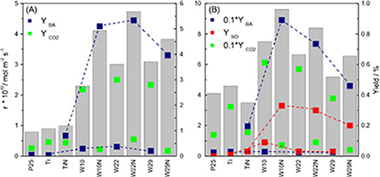
Abstract
A series of nanosized W,N-co-doped anatase TiO2 catalysts with different dopant contents has been prepared by a microemulsion method and examined in the sunlight selective photo-oxidation of toluene and styrene. The activity results have been correlated with structural, electronic, and surface examinations of the catalysts done with the help of XRD-Rietveld, N-2 physisorption and NH3 chemisorption-calorimetry, XPS, Infrared, and UV-visible spectroscopies. Irrespective of the reaction, a consistent reaction rate enhancement with respect to titania (nano-TiO2, P25) references and W-doped TiO2 systems is observed for single-phase anatase W,N-co-doped samples. This is likely linked with the decrease of the band gap energy decrease and results from a combined W-N cooperative effect on structural properties of the anatase network. W,N simultaneous presence also makes a drastic effect on selectivity, maximizing the yield to partial oxidation products. This appears related with surface properties of the materials.
January, 2010 · DOI: 10.1016/j.apcatb.2009.09.039
Nanotecnología en Superficies y Plasma
Synthesis, characterization, and photoactivity of InTaO4 and In0.9Ni0.1TaO4 thin films prepared by electron evaporation
Rico, VJ; Frutos, F; Yubero, F; Espinos, JP; Gonzales-Elipe, ARJournal of Vacuum Science & Technology A, 28 (2010) 127-134 DOI: 10.1116/1.3273597

Abstract
InTaO4 and In0.9Ni0.1TaO4 thin films have been prepared by electron evaporation of successive layers of the single oxide components and posterior annealing at T > 800 degrees C. The annealed thin films presented the monoclinic crystallographic structure typical of these mixed oxides. The electrical and optical behaviors of the films, assessed by C-V measurements, surface conductivity as a function of temperature, and UV-vis absorption spectroscopy, indicate that these oxides are wide band gap semiconductors with a variable dielectric constant depending on the annealing conditions. By reflection electron energy loss spectroscopy some electronic states have been found in the gap at an energy that is compatible with the activation energy deduced from the conductivity versus 1/T plots for these oxides. The photoactivity of these materials has been assessed by looking to the evolution of the wetting contact angle as a function of the irradiation time. All the films became superhydrophilic when irradiated with UV light, while the In0.9Ni0.1TaO4 thin films also presented a small partial decrease in wetting angle when irradiated with visible photons.
January, 2010 · DOI: 10.1116/1.3273597
Microscopic and spectroscopic techniques for the study of paper supports and textile used in the binding of hispano-arabic manuscripts from Al-Andalus: A transition model in the 15th century
Espejo, T; Duran, A; Lopez-Montes, A; Blanc, RJournal of Cultural Heritage, 11 (2010) 50-58 DOI: 10.1016/j.culher.2009.01.007
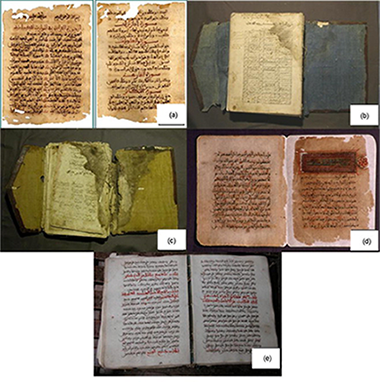
Abstract
This work focuses on the study of paper and textiles used in the binding of a series of manuscripts that share some specific characteristics that lead us to speculate on the possibility of a transitional codicological typology from the Arabic to the Christian book in Al-Andalus during the 15th century. The books we analyzed belong to the collection of the Historical Archive of Malaga, the Archive of Sacromonte Abbey, in Granada, the School of Arabic Studies and the Library of P.P. Escolapios, also in Granada. Paper physical study was performed by microscopic and spectroscopic techniques. A routine and objective method, Fourier Transform Infrared (FTIR) spectroscopy, was employed and proved to be a useful technique for the characterization of cellulosic fibres, main component of paper from the boards and the envelope flap pasteboards, and the fabric lining from the cover. The results of our research will help us to date, identify and study the evolution of the techniques, proving that the materials and innovations of the Italian paper manufacturing processes were perfectly known in the south of modern day Spain, before the Christian Reconquest.
January, 2010 · DOI: 10.1016/j.culher.2009.01.007
Reactividad de Sólidos - Fotocatálisis Heterogénea: Aplicaciones
The Multistep Nature of the Kaolinite Dehydroxylation: Kinetics and Mechanism
Ortega, A; Macias, M; Gotor, FJJournal of the American Ceramic Society, 93 (2010) 197-203 DOI: 10.1111/j.1551-2916.2009.03328.x
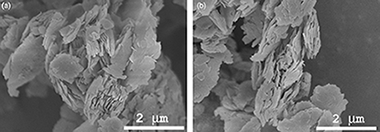
Abstract
The thermal dehydroxylation of kaolinite has been reexamined using small sample weights, a homogeneous particle size distribution and high-vacuum conditions in order to reduce the influences of heat and mass-transfer phenomena. The controlled rate thermal analysis (CRTA) technique, which was specially developed to minimize the pressure and temperature gradients through the sample, was employed to carry out meaningful kinetic experiments. Two advanced isoconversional methods, the Vyazovkin and the Galwey methods, were used complementarily to determine the dependence of the activation energy on the degree of conversion. For this purpose, the Vyazovkin method has been adapted to CRTA experiments. It was demonstrated that there are at least two different stages, revealing the multistep nature of this reaction. The activation energy for the first step, which is assigned to nucleation and the growth of nuclei, decreases from 100 to 75 kJ/mol. The second stage corresponds to a diffusion process and the activation energy rises to 120 kJ/mol because of the metakaolinite formation, which closes the interlamellar channels and leaves isolated patches of kaolinite from which the water escapes with difficulty.
January, 2010 · DOI: 10.1111/j.1551-2916.2009.03328.x
Materiales para Bioingeniería y Regeneración Tisular
Determination of the decay rate constant for hepatocytes immobilized in alginate microcapsules
Leal-Egana, A; Diaz-Cuenca, A; Bader, AJournal of Micoencapsulation, 27 (2010) 86-93 DOI: 10.3109/02652040903050550
Abstract
Primary mouse hepatocytes (between 10-250 cells per capsule) were immobilized within 1.0% w/v alginate microbeads. The textural properties of the alginate matrix were characterized and a full protocol based upon the measurement of the initial rate of Resazurin reduction was studied and standardized. Using this method, the decay rate constant (K-d = 0.45 +/- 0.01 days(-1)) and the time in which the cell viability decreases in half (VI50 = 37 +/- 0.7 h) have been measured. The method was compared with the analysis of cell vitality using Calcein A/M and Ethidium Homodimer I. Differences between the two methods were found in the viability profile due to the significant presence of double stained cells along the culture time. According to the author's knowledge, this is the first report of a systematic study and determination of the K-d value for immobilized hepatocytes, incorporating a wide range of cell concentrations within the alginate matrix.
January, 2010 · DOI: 10.3109/02652040903050550
Materiales y Procesos Catalíticos de Interés Ambiental y Energético
Synthesis and characterization of a LaNiO3 perovskite as precursor for methane reforming reactions catalysts
Pereñiguez, R; Gonzalez-DelaCruz, VM; Holgado, JP; Caballero, AApplied Catalysis B-Environmental, 93 (2010) 346-353 DOI: 10.1016/j.apcatb.2009.09.040
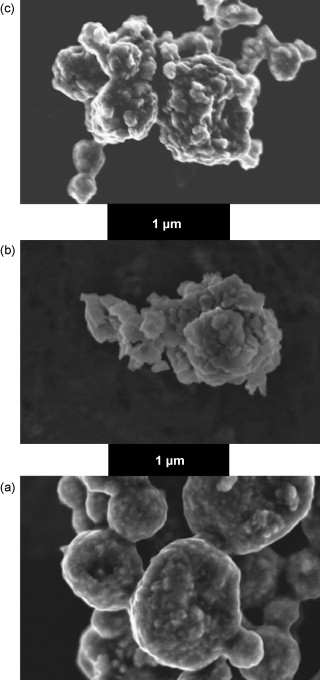
Abstract
The objective of the present work has been the study of the physicochemical and catalytic properties of a Ni/La2O3 catalyst obtained by reduction of a lanthanum nickelite, LaNiO3, with perovskite structure. The perovskite, obtained by means of a spray pyrolysis method, provides a Ni/La2O3 system active in different methane reforming reactions. The catalyst was characterized by scanning electron microscopy (SEM), X-ray diffraction (XRD), X-ray absorption spectroscopy (XAS), X-Ray photoemission spectroscopy (XPS), temperature-programmed reduction and oxidation (TPR, TPO) and catalytic activity tests. Although not evidenced by XRD data, XAS and TPR measurements show the presence of an amorphous NiO phase in the original sample, together with the crystalline LaNiO3 phase. Upon reoxidation treatment of the reduced Ni/La2O3 catalyst, the LaNiO3 structure is partly recovered which provides a convenient way to regenerate a waste catalyst (reoxidation and new reduction in hydrogen). The catalyst is active in several reactions of methane with oxygen, water and CO2, showing a remarkable stability specially under dry reforming of methane (DRM) reaction conditions. This quite great catalytic performance has been explained by the high resistance of the nickel particles to be oxidized, as detected by in situ XAS. In the presence of water, as in steam reforming of methane (SRM) reaction conditions, these metallic particles are gradually oxidized, which explains the linear decreasing of the catalytic performance observed for the SRM reaction.
January, 2010 · DOI: 10.1016/j.apcatb.2009.09.040
Materiales y Procesos Catalíticos de Interés Ambiental y Energético
Chemical and electronic characterization of cobalt in a lanthanum perovskite. Effects of strontium substitution
Hueso, JL; Holgado, JP; Pereniguez, R; Mun, S; Salmeron, M; Caballero, AJournal of Solid State Chemistry, 183 (2010) 27-32 DOI: 10.1016/j.jssc.2009.10.008
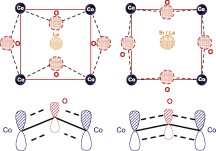
Abstract
Two different cobaltites, LaCoO3 and La0.5Sr0.5CoO3-delta, have been prepared and characterized by means of high energy Co K-edge and low energy O K-edge X-ray absorption spectroscopy (XAS). Even though half of the La(III) is substituted by Sr(II), little or no changes call be detected in the formal oxidation state of cobalt atoms. The presence of strontium cations induces two main effects in the chemical and electronic state of the perovskite. The charge balance with Sr(II) species is reached by the formation of oxygen vacancies throughout the network, which explains the well-known increase in the reactivity of this Substituted perovskite. O K-edge XAS experiments show that the Sr(II) species induce the transitions of d electrons of cobalt cations from low to high Spill Configuration. We propose that this change in Spill Multiplicity is induced by two cooperative effects: the oxygen vacancies. creating five coordinated cobalt atoms, and the bigger size of Sr(II) cations, aligning the Co-O-Co atoms, and favoring the overlapping of pi-symmetry cobalt and oxygen orbitals, reducing the splitting energy of e(g) and t(2g) levels.
January, 2010 · DOI: 10.1016/j.jssc.2009.10.008
Nanotecnología en Superficies y Plasma - Materiales Ópticos Multifuncionales
Conformal Growth of Organic Luminescent Planar Defects within Artificial Opals
Aparicio, FJ; Lozano, G; Blaszczyk-Lezak, I; Barranco, A; Miguez, HChemistry of Materials, 22 (2010) 379-385 DOI: 10.1021/cm902819x
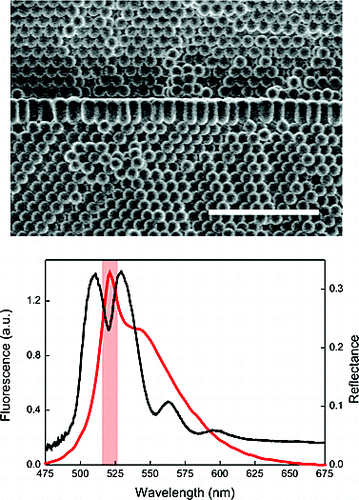
Abstract
Herein, we present the result of combining, for the first time, the techniques of colloidal self-assembly and plasma-enhanced chemical vapor deposition to create a novel, high-quality, purely Organic active photonic crystal structure of controlled optical properties. We show a fast. reliable, and accurate procedure to introduce two-dimensional luminescent organic defect layers within artificial polystyrene opals via a versatile room-temperature remote plasma deposition process. This method is gentle enough to allow highly coil formal growth on polystyrene microspheres without altering their morphology or the ordered arrangement that they form. The luminescent organic layer behaves both as all optical dopant, causing the opening of transmission windows within the forbidden frequency interval of the lattice, and as an optically active material, whose emission call be tailored by the photonic environment.
January, 2010 · DOI: 10.1021/cm902819x
Química de Superficies y Catálisis
Supported nickel catalysts with a controlled molecular architecture for the catalytic reformation of methane
Hufschmidt, D; Bobadilla, LF; Romero-Sarria, F; Centeno, MA; Odriozola, JA; Montes, M; Falabella, ECatalysis Today, 149 (2010) 394-400 DOI: 10.1016/j.cattod.2009.06.002

Abstract
In this work a lanthanum and nickel catalyst having perovskite structure, grown on a gamma-alumina carrier, is being presented. The structure of the catalyst was confirmed by XRD. The behaviour of this material under the conditions of steam reforming has been studied and the influence of the temperature, the space velocity and the steam/carbon ratio on the conversion of methane and the product distribution in the process was determined. In all cases at higher temperatures conversions of more than 90% and high selectivities were achieved. The experiments to determine the stability of the catalyst demonstrated that no deactivation in experimental runs of more than 17h occurred. Additionally a study of the catalyst after the reaction showed that only lowly structured carbonaceous species were formed on the catalyst surface, which is not expected to inhibit strongly the initial catalytic activity.
January, 2010 · DOI: 10.1016/j.cattod.2009.06.002
2009
2009
Materiales Nanoestructurados y Microestructura
Metal carbide/amorphous C-based nanocomposite coatings for tribological applications
Sanchez-Lopez, JC; Martinez-Martinez, D; Abad, MD; Fernandez, ASurface and Coatings Technology, 204 (2009) 947-954 DOI: 10.1016/j.surfcoat.2009.05.038

Abstract
This paper tries to assess the factors governing the tribological behaviour of different nanocomposites films composed by metallic carbides (MeC) mixed with amorphous carbon (a-C). Different series of MeC/a-C coatings (with Me: Ti(B) and W) were prepared by magnetron sputtering technique varying the power applied to the graphite target in order to tailor the carbon content into the films. A deep investigation of the chemical and structural features at the nano-scale is carried out by X-ray diffraction (XRD), X-ray photoelectron spectroscopy (XPS), electron energy-loss spectroscopy (EELS) and Raman spectroscopy techniques in order to establish correlations with the tribological properties measured by a pin-on-disk tribometer in ambient air. The analysis of the counterfaces by Raman confocal microscopy after the friction tests is used to follow the chemical phenomena occurring at the contact area responsible of the observed friction behaviour. The importance of determining the fraction of C atoms in the amorphous phase (xa-C) is highlighted as a key-parameter to control the tribological properties. A comparative analysis of the mechanical and tribological performance of the three systems (TiC/a-C, WC/a-C, TiBC/a-C) is done and conclusions are obtained concerning the friction and wear mechanism involved.
December, 2009 · DOI: 10.1016/j.surfcoat.2009.05.038
Characterization of illuminated manuscripts by laboratory-made portable XRD and micro-XRD systems
Duran, A; Perez-Rodriguez, JL; Espejo, T; Franquelo, ML; Castaing, J; Walter, PAnalytical and Bioanalytical Chemistry, 395 (2009) 1997-2004 DOI: 10.1007/s00216-009-2992-5
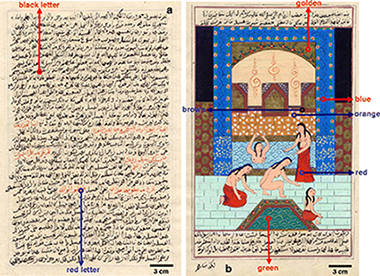
Abstract
Illuminated Arabic manuscripts have been studied, employing two laboratory-made X-ray diffraction (XRD) systems developed recently in the C2RMF laboratory. The validity of the µ-XRD and XRD portable systems for the study of this type of artworks has been demonstrated. A common observation in all the analyses is the presence of calcite and rutile; also, hematite, goethite, cinnabar, brass, anatase and barite were detected in the various colours. Differences between the results obtained by both techniques due to acquisition mode are discussed. In addition, other techniques such as X-ray fluorescence (XRF) and micro-Raman were used for the complete characterization of the manuscripts.
December, 2009 · DOI: 10.1007/s00216-009-2992-5
Materiales de Diseño para la Energía y Medioambiente
Reversibility of La and Lu sorption onto smectites: Implications for the design of engineered barriers in deep geological repositories
Galunin, E; Alba, MD; Aviles, MA; Santos, MJ; Vidal, MJournal of Hazardous Materials, 172 (2009) 1198-1205 DOI: 10.1016/j.jhazmat.2009.07.124
Abstract
The sorption reversibility of La and Lu (considered as actinide analogues) onto a set of smectites (bentonite FEBEX; hectorite, HEC; MX80; saponite, SAP; Otay montmorillonite, SCa-3; and Texas montmorillonite, STx-1) was studied to estimate actinide retention by smectites that are candidates for use as engineered barriers in deep geological repositories. The sorption distribution coefficients (K d) and the reversibility parameters (desorption distribution coefficients (K d,des), adjusted distribution coefficients (K d,adj), and desorption rates (R des)) were determined from batch tests in two ionic media: deionized water and Ca 0.02 mol L -1. The latter simulates possible conditions due to the presence of concrete leachates. The results varied greatly depending on the ionic medium, the lanthanide concentration and the clay structure. The high values of K d,des obtained (up to 1.1 × 10 5 and 9.2 × 10 4 L kg -1 for La and Lu in water, and 2.8 × 10 4 and 4.1 × 10 4 L kg -1 for La and Lu in the Ca medium) indicate the suitability of the tested smectites for lanthanide (and therefore, actinide) retention. Based on all the data, SCa-3, HEC and FEBEX clays are considered the best choices for water environments, whereas in Ca environments the suitable clays depended on the lanthanide considered.
December, 2009 · DOI: 10.1016/j.jhazmat.2009.07.124
Study of metallic components of historical organ pipes using synchrotron radiation X-ray microfluorescence imaging and grazing incidence X-ray diffraction
Herrera, LK; Justo, A; Munoz-Paez, A; Sans, JA; Martinez-Criado, GAnalytical and Bioanalytical Chemistry, 395 (2009) 1969-1975 DOI: 10.1007/s00216-009-3075-3
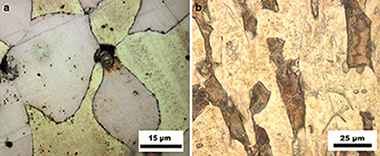
Abstract
A comparative study of the composition and microstructure of two different brass alloys from reed pipes, one from a Spanish baroque organ and the other from a modern one, was carried out. This study allowed us to determine the procedure followed to produce the brass used to make ancient reed pipes. Moreover the distribution and correlation of lead and other trace elements present into the main component of the brass, the copper and zinc phases, of the historical tongues and shallots were established. This chemical composition was compared with that of a tongue from a twentieth-century organ. The whole study was accomplished using a combination of laboratory and synchrotron radiation techniques. X-ray fluorescence was the technique used to obtain elemental and chemical imaging of the main phases and the trace elements at a sub-micrometer scale.
December, 2009 · DOI: 10.1007/s00216-009-3075-3
Materiales Nanoestructurados y Microestructura
Thermogravimetric and in situ SEM characterisation of the oxidation phenomena of protective nanocomposite nitride films deposited on steel
Mege-Revil, A; Steyer, P; Thollet, G; Chiriac, R; Sigala, C; Sanchez-Lopez, JC; Esnouf, CSurface and Interface Analysis, 204 (2009) 893-901 DOI: 10.1016/j.surfcoat.2009.06.040

Abstract
The lifetime of TiN coatings is often limited by its poor resistance to high temperatures. For an optimized addition of silicon, both mechanical and physico-chemical properties are enhanced, owing to the formation of a nanocomposite structure. In this study, pure Ti and TiSi (80/20) targets were arc-evaporated to produce hard, single-layered coatings. Magnetron sputtered SiNx films were also synthesized for a comparison purpose. The nanocomposite structure was determined by XRD and TEM, and its efficiency regarding the mechanical properties was confirmed by nanohardness measurements. Through thermogravimetric experiments it is shown that in isothermal and dynamic conditions, the chemical stability inherent to SiNx controls the oxidation behaviour of TiSiN. However, in thermal cycling conditions TiSiN withstand efficiently temperature variations whereas SiNx does not. The aim of this study is to understand the role of SiNx on the oxidation of the TiSiN nanocomposite film. For this purpose, an in situ approach of the oxidation phenomena is detailed, based on experiments performed in an environmental scanning electron microscope (ESEM) operating in controlled pressure mode up to 1000 °C. ESEM, used in real-time oxidative conditions, has been proved to be an efficient tool to characterise the mechanism of degradation. The successive steps of the attack throughout the in situ oxidation process are as follow: oxidation first initiates at coating defects (open pores and droplets), then spreads to the whole surface. The whole flaking of the film that is observed at the microscopic scale during the cooling step proves the poor thermal fatigue resistance of SiNx. This strong propensity to cracking is explained on the basis of thermo-mechanical considerations. The nanocomposite structure thus combines the chemical stability inherent to the SiNx matrix with the beneficial thermo-mechanical properties associated to TiN nanograins.
December, 2009 · DOI: 10.1016/j.surfcoat.2009.06.040
Characterization of sepiolite-gel-based formulations for controlled release of pesticides
Maqueda, C; Partal, P; Villaverde, J; Perez-Rodriguez, JLApplied Clay Science, 46 (2009) 289-295 DOI: 10.1016/j.clay.2009.08.019
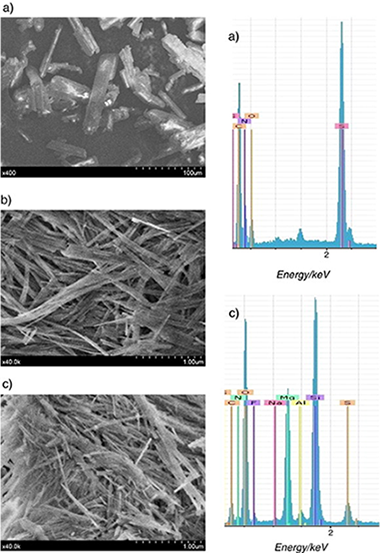
Abstract
Novel controlled release formulations (CRFs) were developed for reducing leaching of herbicides and contamination of groundwater. The herbicide metribuzin (MTB) was entrapped within a sepiolite-gel matrix using a novel and ultrasound-based technique. Different sepiolite/herbicide matrices (either as a gel or as a powder after freeze-drying) were prepared with pesticide loading between 28.6 and 9.1%. The release of MTB from the control released formulations into water was retarded when compared with commercial formulation (CF), except in the case of the sepiolite-gel-based formulations with lower amounts of sepiolite. The rheological properties and microstructure of these formulations were examined in detail. FTIR spectra showed that there was no evidence of herbicide inside the sepiolite tunnels. The SEM micrograph of the sepiolite-gel-based formulations showed the fibrous morphology typical of sepiolite and no separate particles of MTB were found. However, the chemical analysis by EDX confirmed the presence of S, N, and C, which were attributed to MTB, together with the fibers of sepiolite. Rheological characterization indicated that samples containing MTB develops a microstructure, which is irrespective of concentration above 1 mass % sepiolite. There was a good agreement between the microstructure characteristics and MTB release behavior.
November, 2009 · DOI: 10.1016/j.clay.2009.08.019
Materiales de Diseño para la Energía y Medioambiente
Synthesis and characterization of a plant cutin mimetic polymer
Heredia-Guerrero, JA; Heredia, A; Garcia-Segura, R; Benitez, JJPolymer, 50 (2009) 5633-5637 DOI: 10.1016/j.polymer.2009.10.018
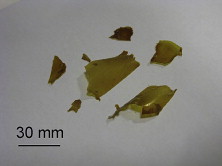
Abstract
A mimetic polymer of plant cutin have been synthesized from 9,10,16-trihydroxyhexadecanoic (aleuritic) acid through a low temperature polycondensation reaction. Reaction conditions (solvent, catalyst, temperature, etc…) were studied and modified to optimize yield and product characteristics. The resulting polyaleurate polymer was characterized by Attenuated Total Reflection-Fourier Transform Infrared Spectroscopy (ATR-FTIR), Differential Scanning Calorimetry (DSC), X-ray Diffraction (XRD) and solid state 13C-Cross Polarization/Magic Angle Spinning Nuclear Magnetic Resonance (13C-CP/MAS NMR). Mechanical and hydrodynamic properties were also investigated. In the average, the product obtained is physically and chemically very similar to plant cutin (a hydrophobic polyester). However, a more detailed analysis of results reveals that polyaleurate framework is more rigid than natural cutin and with additional larger short-range ordered domains. Also, the synthetic polymer displays slightly different mechanical properties with respect to natural cutin. Additional hydrogen bonding within the framework of polyaleurate is considered to be responsible for such experimental observations.
November, 2009 · DOI: 10.1016/j.polymer.2009.10.018
Materiales Nanoestructurados y Microestructura
Bonding Structure and Mechanical Properties of Ti-B-C Coatings
Abad, MD; Caceres, D; Pogozhev, YS; Shtansky, DV; Sanchez-Lopez, JCPlasma Processes and Polymers, 6 (2009) S107-S112 DOI: 10.1002/ppap.200930403
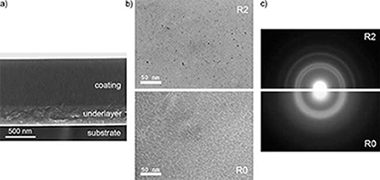
Abstract
Nanocomposite coatings combining hard phases (TiB2, TiC) with an amorphous carbon (a-C) were developed to provide a good compromise between mechanical and tribological properties for M2 steels used in a wide variety of applications such as cutting tools, bearings and gear mechanisms. A combined d.c.-pulsed and r.f.-magnetron deposition process was used to deposit nanocomposite TiBC/a-C coatings with a variable content of carbon matrix phase. Chemical composition was determined by electron energy loss spectroscopy (EELS) and X-ray photoelectron spectroscopy (XPS). Transmission electron microscopy (TEM) revealed that the coatings microstructure is rather amorphous with small nanocrystals of TiC and/or TiB2 (not possible to differentiate by diffraction techniques). Investigation of the chemical bonding environment by XPS and EELS allows us to confirm the presence of titanium-boron and titanium-carbon bonds together with free a-C. Coatings exhibited hardness values (H) of 25–29 GPa, effective Young modulus (E*) of 310–350 GPa, H/E* ratios over 0.080 and resistance to plastic deformation (H3/E*2) from 0.15 to 0.20. Tribological properties of the coatings were characterized by a pin-on-disk tribometer using steel and WC balls at high contact stresses (1.1 and 1.4 GPa respectively). Friction coefficients were reduced from 0.6 to 0.2 by increasing the content of free carbon without reduction of the hardness (around 28 GPa), by self-lubricant effects. The tribo-mechanical data are revised according to the phase composition and chemical bonding inside the nanocomposites.
November, 2009 · DOI: 10.1002/ppap.200930403
Materiales de Diseño para la Energía y Medioambiente
The hydrothermal conversion of kaolinite to kalsilite: Influence of time, temperature, and pH
Becerro, AI; Escudero, A; Mantovani, MAmerican Mineralogist, 94 (2009) 11-12 DOI: 10.2138/am.2009.3284
Abstract
Kalsilite (the low-temperature form of KAlSiO4) is used as the precursor of leucite, an important component in porcelain-fused-to-metal and ceramic-restoration systems, and it has also been proposed as a high-thermal expansion ceramic for bonding to metals. The present study reports the hydrothermal synthesis and characterization of pure kalsilite from kaolinite in subcritical conditions, as well as the characterization of the intermediate products by means of XRD, 29Si and 27Al MAS NMR, IR, SEM, and TEM. Effects of time, temperature, and pH on the reaction products are analyzed. The experimental data indicate that pure kalsilite is obtained after hydrothermal treatment of kaolinite at 300 °C for 12 h in 0.5 M KOH solution. Longer reaction times increase the crystallinity of the structure, whereas lower reaction times give rise to the metastable ABW-type KAlSiO4 polymorph. Lower temperatures are not sufficient to produce kalsilite, but zeolite W is obtained instead as the unique reaction product. Finally, the pH of the aqueous solution in contact with kaolinite is an important parameter for the synthesis of kalsilite, which must be ≥13.70.
November, 2009 · DOI: 10.2138/am.2009.3284
Química de Superficies y Catálisis
Self-Assembling of Er2O3-TiO2 Mixed Oxide Nanoplatelets by a Template-Free Solvothermal Route
Julian-Lopez, B; Martos, M; Ulldemolins, N; Odriozola, JA; Cordoncillo, E; Escribano, PChemistry-A European Journal, 15 (2009) 12426-12434 DOI: 10.1002/chem.200901423
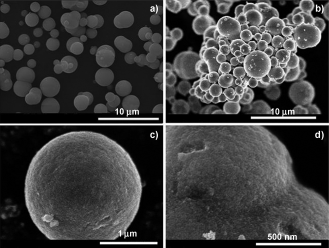
Abstract
An easy solvothermal route has been developed to synthesize the first mesoporous Er2O3-TiO2 mixed oxide spherical particles composed of crystalline nanoplatelets, with high surface area and narrow pore size distribution. This synthetic strategy allows the preparation of materials at low temperature with interesting textural properties without the use of surfactants, as well as the control of particle size and shape. TEM and Raman analysis confirm the formation of nanocrystalline Er2O 3-TiO2 mixed oxide. Mesoscopic ordered porosity is reached through the thermal decomposition of organic moieties during the synthetic process, thus leading to a template-free methodology that can be extended to other nanostructured materials. High specific surface areas (up to 313 m 2g-1) and narrow pore size distributions are achieved in comparison to the micrometric material synthesized by the traditional sol-gel route. This study opens new perspectives in the development, by solvothermal methodologies, of multifunctional materials for advanced applications by improving the classical pyrochlore properties (magnetization, heat capacity, catalysis, conductivity, etc.). In particular, since catalytic reactions take place on the surface of catalysts, the high surface area of these materials makes them promising candidates for catalysts. Furthermore, their spherical morphology makes them appropriate for advanced technologies in, for instance, ceramic inkjet printers.
November, 2009 · DOI: 10.1002/chem.200901423
Advanced combined application of μ-X-ray diffraction/μ-X-ray fluorescence with conventional techniques for the identification of pictorial materials from Baroque Andalusia paintings
Herrera, LK; Montalbani, S; Chiavari, G; Cotte, M; Sole, VA; Bueno, J; Duran, A; Justo, A; Perez-Rodriguez, JLTalanta, 80 (2009) 71-83 DOI: 10.1016/j.talanta.2009.06.032
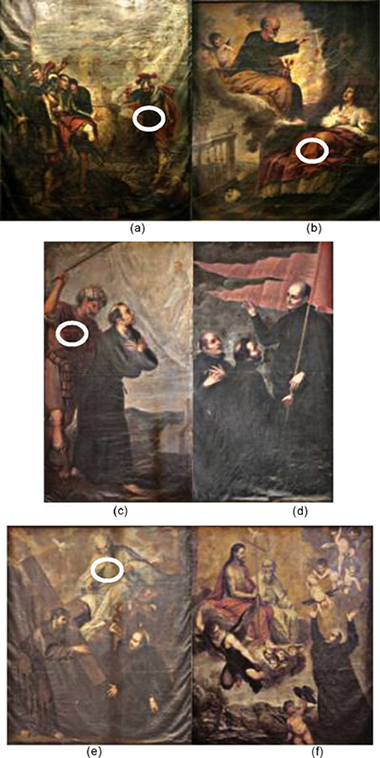
Abstract
The process of investigating paintings includes the identification of materials to solve technical and historical art questions, to aid in the deduction of the original appearance, and in the establishment of the chemical and physical conditions for adequate restoration and conservation. In particular, we have focused on the identification of several samples taken from six famous canvases painted by Pedro Atanasio Bocanegra, who created a very special collection depicting the life of San Ignacio, which is located in the church of San Justo y Pastor of Granada, Spain. The characterization of the inorganic and organic compounds of the textiles, preparation layers, and pictorial layers have been carried out using an XRD diffractometer, SEM observations, EDX spectrometry, FT-IR spectrometry (both in reflection and transmission mode), pyrolysis/gas chromatography/mass spectrometry and synchrotron-based μ-X-ray techniques. In this work, the advantages over conventional X-ray diffraction of using combined synchrotron-based μ-X-ray diffraction and μ-X-ray fluorescence in the identification of multi-layer paintings is demonstrated.
November, 2009 · DOI: 10.1016/j.talanta.2009.06.032
Química de Superficies y Catálisis
Methane steam reforming in a microchannel reactor for GTL intensification: A computational fluid dynamics simulation study
Arzamendia, G; Dieguez, PM; Montes, M; Odriozola, JA; Sousa-Aguiar, EF; Gandia, LMChemical Engineering Journal, 154 (2009) 168-173 DOI: 10.1016/j.cej.2009.01.035

Abstract
The integration of the steam reforming and combustion of methane in a catalytic microchannel reactor has been simulated by computational fluid dynamics (CFD). Two models including 4 or 20 square microchannels of 20 mm of length and 0.7 mm of side have been developed. It has been assumed that a thin and homogeneous layer of an appropriate catalyst has been uniformly deposited onto the channels walls. The kinetics of the steam reforming of methane (SRM), water-gas shift (WGS) and methane combustion in air have been incorporated into the models. This has allowed simulating the effect of the gas streams space velocities, catalyst load, steam-to-carbon (S/C) ratio and flow arrangement on the microreformer performance. The results obtained illustrate the potential of microreactors for process intensification: complete combustion of methane is achieved at gas hourly space velocities (GHSV) as high as 130,000 h−1. As concerns the SRM, methane conversions above 97% can be obtained at high GHSV of 30,000 h−1 and temperatures of 900–950 °C. Under these conditions selectivity for syngas is controlled by the WGS equilibrium.
November, 2009 · DOI: 10.1016/j.cej.2009.01.035
Nanotecnología en Superficies y Plasma
Hybrid catalytic-DBD plasma reactor for the production of hydrogen and preferential CO oxidation (CO-PROX) at reduced temperatures
Rico, VJ; Hueso, JL; Cotrino, J; Gallardo, V; Sarmiento, B; Brey, JJ; Gonzalez-Elipe, ARChemical Communications, 41 (2009) 6192-6194 DOI: 10.1039/b909488a
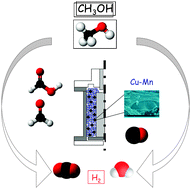
Abstract
Dielectric Barrier Discharges (DBD) operated at atmospheric pressure and working at reduced temperatures (T < 115 °C) and a copper–manganese oxide catalyst are combined for the direct decomposition and the steam reforming of methanol (SRM) for hydrogen production and for the preferential oxidation of CO (CO-PROX)
November, 2009 · DOI: 10.1039/b909488a
Química de Superficies y Catálisis
Ionic liquid templated TiO2 nanoparticles as a support in gold environmental catalysis
Avellaneda, RS; Ivanova, S; Sanz, O; Romero-Sarria, F; Centeno, MA; Odriozola, JAApplied Catalysis B-Environmental, 93 (2009) 140-148 DOI: 10.1016/j.apcatb.2009.09.023
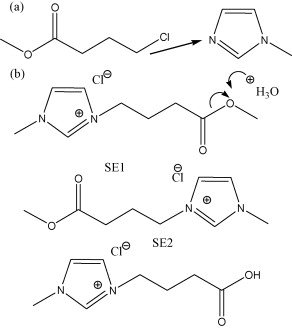
Abstract
This work presents the synthesis of a nanostructured titania support and its subsequent utilization for the gold particles deposition and application in the reaction of the CO oxidation. A functionalized ionic liquid has been used as a templating agent for the titanium oxide synthesis resulting in a high specific surface nanostructured titania anatase. The as prepared support was then used for gold nanoparticles deposition without ionic liquid removal in order to study the possible role of the latter in the stabilization of the gold particles. The presence of ionic liquid in the catalysts results in an unusual catalytic behaviour—strong dependence on the presence of CO and changed kinetics and rate of oxidation.
November, 2009 · DOI: 10.1016/j.apcatb.2009.09.023
Reactividad de Sólidos
Combined kinetic analysis of thermal degradation of polymeric materials under any thermal pathway
Sanchez-Jimenez, PE; Perez-Maqueda, LA; Perejon, A; Criado, JMPolymer Degradation and Stability, 94 (2009) 2079-2085 DOI: 10.1016/j.polymdegradstab.2009.07.006
Abstract
Combined kinetic analysis has been applied for the first time to the thermal degradation of polymeric materials. The combined kinetic analysis allows the determination of the kinetic parameters from the simultaneous analysis of a set of experimental curves recorded under any thermal schedule. The method does not make any assumptions about the kinetic model or activation energy and allows analysis even when the process does not follow one of the ideal kinetic models already proposed in the literature. In the present paper the kinetics of the thermal degradation of both polytetrafluoroethylene (PTFE) and polyethylene (PE) have been analysed. It has been concluded, without previous assumptions on the kinetic model, that the thermal degradation of PTFE obeys a first order kinetic law, while the thermal degradation of PE follows a diffusion-controlled kinetic model.
November, 2009 · DOI: 10.1016/j.polymdegradstab.2009.07.006
Hg/Sn amalgam degradation of ancient glass mirrors
Herrera, LK; Duran, A; Franquelo, ML; Justo, A; Perez-Rodriguez, JLJournal of Non-Crystalline Solids, 355 (2009) 1980-1983 DOI: 10.1016/j.jnoncrysol.2008.11.045
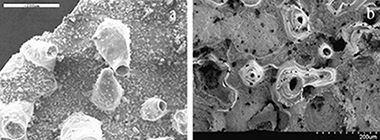
Abstract
Tin amalgam, which is obtained by pouring mercury onto a sheet of tin, has been used in the production of reflective coatings for mirrors. The corrosion processes of the amalgam layer were investigated in several mirrors from historical buildings located in southern Spain using SEM/EDS, XPS, and GID. Mercury and Sn4+ are present as spheres on the amalgam surface due to the evaporation process (∼5 nm). The profile shows a mixture of Sn2+ and Sn4+. The original amalgam was composed of a binary alloy of tin and mercury (Hg0.1Sn0.9) and metallic tin. In this paper the tin oxidation mechanism of the amalgam is described. Liquid mercury is volatile and evaporates slowly, leaving fine tin particles that oxidize easily, forming tin monoxide (SnO) and tin dioxide (SnO2). The mercury-rich phase accelerates the corrosion of the tin-rich phase.
October, 2009 · DOI: 10.1016/j.jnoncrysol.2008.11.045
Materiales Ópticos Multifuncionales
Optical Analysis of the Fine Crystalline Structure of Artificial Opal Films
Lozano, G; Dorado, LA; Schinca, D; Depine, RA; Miguez, HLangmuir, 25 (2009) 12860-12864 DOI: 10.1021/la903077r
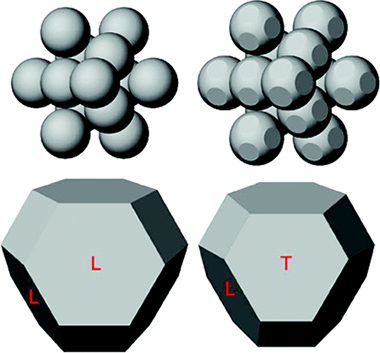
Abstract
Herein, we present a detailed analysis of the structure of artificial opal films. We demonstrate that, rather than the generally assumed face centered cubic lattice of spheres, opal films are better approximated by rhombohedral assemblies of distorted colloids. Detailed analysis of the optical response in a very wide spectral range (0.4 ≤ a/λ ≤ 2, where a is the conventional lattice constant), as well as at perpendicular and off-normal directions, unambiguously shows that the interparticle distance coincides very approximately with the expected diameter only along directions contained in the same close-packed plane but differs significantly in directions oblique to the [111] one. A full description of the real and reciprocal lattices of actual opal films is provided, as well as of the photonic band structure of the proposed arrangement. The implications of this distortion in the optical response of the lattice are discussed.
October, 2009 · DOI: 10.1021/la903077r
Materiales Ópticos Multifuncionales
Mesostructured Thin Films as Responsive Optical Coatings of Photonic Crystals
Hidalgo, N; Calvo, ME; Miguez, HSmall, 5 (2009) 2309-2315 DOI: 10.1002/smll.200900411
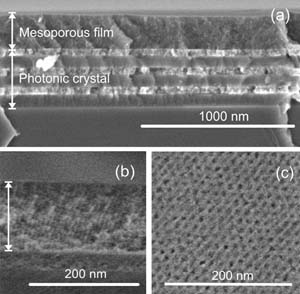
Abstract
A synthetic route is presented to attain high-optical-quality multilayered structures that residtfront coupling ordered n7esoporous tilaniuni oxide thin films to the surface of a dense one-dimensional photonic crystal. Such architectures present spectrally well-defined photon resonant modes localized in the outer coating that finely respond to physicochemically induced modifications of its pore volume. The potential of these porous coatings in detection of environmental changes through variations of the photonic response of the ensemble is demonstrated by performing isothermal optical reflectance measurements under controlled vapor-pressure conditions.
October, 2009 · DOI: 10.1002/smll.200900411
Química de Superficies y Catálisis - Materiales Nanoestructurados y Microestructura
Manganese and iron oxides as combustion catalysts of volatile organic compounds
Duran, FG; Barbero, BP; Cadus, LE; Rojas, C; Centeno, MA; Odriozola, JAApplied Catalysis B-Environmental, 92 (2009) 194-201 DOI: 10.1016/j.apcatb.2009.07.010
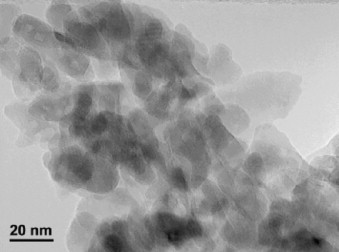
Abstract
FeMn mixed oxides were prepared by the citrate method with Fe:Mn atomic ratio equal to 1:1, 1:3 and 3:1. The sample was characterized by means of specific surface area measurements, X-ray diffractometry (XRD), temperature programmed desorption of oxygen (O2-DTP), temperature programmed reduction (TPR), X-ray fluorescence (XRF), transmission electron microscopy (TEM and SAED) and high resolution TEM (HREM). The characterization results demonstrated the formation of a Mn2O3–Fe2O3 solid solution. The catalytic performance in ethanol, ethyl acetate and toluene total oxidation on these samples was better than on Fe2O3 and Mn2O3 pure oxides.
October, 2009 · DOI: 10.1016/j.apcatb.2009.07.010
Materiales de Diseño para la Energía y Medioambiente
Hydrothermal Synthesis of Kalsilite: A Simple and Economical Method
Becerro, AI; Mantovani, M; Escudero, AJournal of the American Ceramic Society, 92 (2009) 2204-2206 DOI: 10.1111/j.1551-2916.2009.03232.x
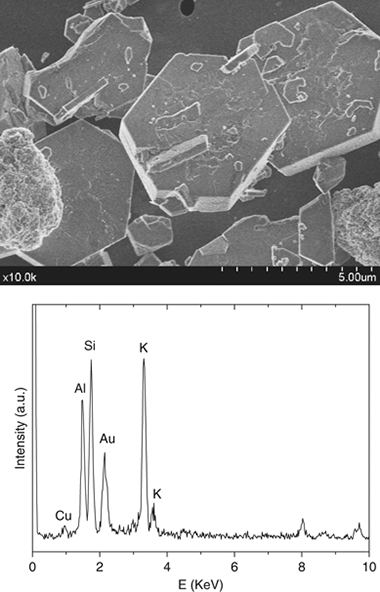
Abstract
This study reports a simple method to synthesize pure kalsilite (KAlSiO4) using readily available precursors, kaolinite and KOH solution, after only 12 h of hydrothermal treatment in mild conditions. A structural refinement has been carried out using the Rietveld method to obtain unit cell parameters, and the 29Si and 27Al magic angle spinning nuclear magnetic resonance spectra have shown the purity and complete Si/Al ordering of the kalsilite structure obtained. Finally, the morphology of the particles has been analyzed by scanning electron microscopy.
October, 2009 · DOI: 10.1111/j.1551-2916.2009.03232.x
Nanotecnología en Superficies y Plasma - Materiales Nanoestructurados y Microestructura
Vibrational spectroscopy characterization of magnetron sputtered silicon oxide and silicon oxynitride films
Godinho, V; Denisov, VN; Mavrin, BN; Novikova, NN; Vinogradov, EA; Yakovlev, VA; Fernandez-Ramos, C; de Haro, MCJ; Fernandez, AApplied Surface Science, 256 (2009) 156-164 DOI: 10.1016/j.apsusc.2009.07.101

Abstract
Vibrational (infrared and Raman) spectroscopy has been used to characterize SiOxNy and SiOx films prepared by magnetron sputtering on steel and silicon substrates. Interference bands in the infrared reflectivity measurements provided the film thickness and the dielectric function of the films. Vibrational modes bands were obtained both from infrared and Raman spectra providing useful information on the bonding structure and the microstructure (formation of nano-voids in some coatings) for these amorphous (or nanocrystalline) coatings. X-ray photoelectron spectroscopy (XPS) and scanning electron microscopy (SEM) analysis have also been carried out to determine the composition and texture of the films, and to correlate these data with the vibrational spectroscopy studies. The angular dependence of the reflectivity spectra provides the dispersion of vibrational and interference polaritons modes, what allows to separate these two types of bands especially in the frequency regions where overlaps/resonances occurred. Finally the attenuated total reflection Fourier transform infrared measurements have been also carried out demonstrating the feasibility and high sensitivity of the technique. Comparison of the spectra of the SiOxNy films prepared in various conditions demonstrates how films can be prepared from pure silicon oxide to silicon oxynitride with reduced oxygen content.
October, 2009 · DOI: 10.1016/j.apsusc.2009.07.101
Materiales de Diseño para la Energía y Medioambiente
Rare-earth disilicate formation under Deep Geological Repository approach conditions
Alba, MD; Chain, P; Orta, MMApplied Clay Science, 46 (2009) 63-68 DOI: 10.1016/j.clay.2009.07.012
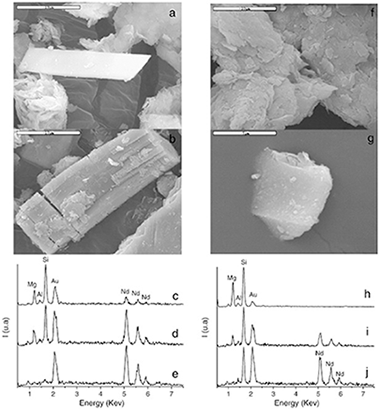
Abstract
The Deep Geological Repository (DGR) concept involves the placement of long-lived radioactive waste in rooms excavated deep. The major responsibility of the disposal safety falls on the Engineered Barrier System (EBS). The main constituent of EBS is bentonite that prevents the release of radiactive nuclei by physical and chemical mechanisms. The physical mechanism is expected to fault with the weathering of the bentonite while the chemical mechanisms have been only proved at 300 °C. It is the aim of this paper to explore the feasibility of the chemical mechanism at temperatures closer to the DGP conditions and to shed light on the mechanism of transformation of the argillaceous materials of the EBS in rare-earth disilicate phases. Saponite was submitted to hydrothermal reaction at 175 °C and 150 °C with different solutions of REE3+ cations (REE = Sc, Lu, Y, Sm, Nd and La). The products were analyzed by XRD, NMR and electron microscopy. At conditions close to the DGP, the saponite was able to form rare-earth silicates. The formation of the disilicate phase, as final product, needs a set of stages and oxyorthosilicate as precursor.
September, 2009 · DOI: 10.1016/j.clay.2009.07.012
Nanotecnología en Superficies y Plasma
Formation of Nitrogen Functional Groups on Plasma Treated DLC
Lopez-Santos, C; Yubero, F; Cotrino, J; Contreras, L; Barranco, A; Gonzalez-Elipe, ARPlasma Processes and Polymers, 6 (2009) 555-565 DOI: 10.1002/ppap.200900019

Abstract
Diamond like carbon (DLC) thin films have been exposed to different nitrogen containing plasmas. A dielectric barrier discharge (DBD) at atmospheric pressure and a microwave discharge (MW) at low pressure using N2 and mixtures Ar + NH3 have been compared. Optical Emission and X-ray Photoelectron spectroscopies, Atomic Force Microscopy and contact angle measurements have been used for this study. A DBD with Ar + NH3 is the most efficient method for DLC functionalization. Films treated with this plasma presented the highest concentration of amine groups as determined by derivatization with 4-chlorobenzaldehyde. All the treated samples underwent a significant aging with time. The efficiency of the different plasmas for DLC functionalization is discussed in the light of the intermediate species detected in the plasma.
September, 2009 · DOI: 10.1002/ppap.200900019
Nanotecnología en Superficies y Plasma
Identification of hydrogen and deuterium at the surface of water ice by reflection electron energy loss spectroscopy
Yubero, F; Tokesi, KApplied Physics Letters, 95 (2009) 084101 DOI: 10.1063/1.3202402

Abstract
A nondestructive method to distinguish between hydrogen (H) and deuterium (D) at surfaces by reflection electron energy loss spectroscopy is presented. It is based on the analysis of the energy distributions of electrons elastically backscattered from surfaces containing H or D. We consider standard and deuterated water ices as test surfaces. The recoil energy of the backscattered electrons depends on the atomic mass of the targets, and the contributions of H, D, and O to the measured spectra can be easily separated. The results of Monte Carlo simulations corroborate the experimental findings.
August, 2009 · DOI: 10.1063/1.3202402
Reactividad de Sólidos
High surface area α-alumina preparation by using urban waste
Martin-Ruiz, MM; Perez-Maqueda, LA; Cordero, T; Balek, V; Subrt, J; Murafa, N; Pascual-Cosp, JCeramics International, 35 (2009) 2111-2117 DOI: 10.1016/j.ceramint.2008.11.011
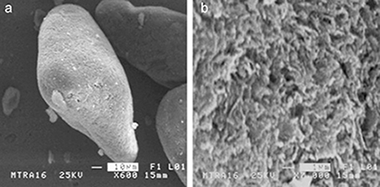
Abstract
A new method for preparing high surface area α-alumina from urban waste is proposed. The method consists of the precipitation of a precursor that contains bohemite mixed with a linear polymer and subsequently the thermal decomposition of the precursor by heating in nitrogen and air to 1200 °C. The resulting α-alumina consists of nanocrystals of about 100 nm aggregated into larger particles with relatively high surface area (12 m2 g−1) and a significant macropore volume of 0.545 cm3 g. Methods of X-ray diffraction (XRD), scanning electron microscopy (SEM), high-resolution transmission electron microscopy (HRTEM) and selected area electron diffraction (SAED) were used to characterize microstructure of prepared materials. Results of differential thermal analysis, thermogravimetry and emanation thermal analysis characterized the thermal behaviour of α-alumina precursors.
August, 2009 · DOI: 10.1016/j.ceramint.2008.11.011
Materiales Coloidales
Synthesis by pyrolysis of aerosols and ceramic application of Cr-doped CaYAlO4 red–orange pigments
Lyubenova, TS; Carda, JB; Ocana, MJournal of the European Ceramic Society, 29 (2009) 2193-2198 DOI: 10.1016/j.jeurceramsoc.2009.01.020

Abstract
The synthesis of red–orange Cr-doped YCaAlO4 pigments has been improved (softer thermal conditions and lower environmental impact) and optimised by using the pyrolysis of aerosols method. We also study the crystallochemical features of the Cr chromophore with special emphasis on its oxidation state which has not been yet clarified, finding that Cr(III) and Cr(IV) species are present in the octahedral and interstitial tetrahedral sites of the YCaAlO4 lattice, respectively. Finally, the applicability of this system as ceramic pigment was tested using conventional industrial glazes. A change from orange to pink shades was detected after glaze firing, which is mainly attributed to the Cr3+ to Cr4+ oxidation.
August, 2009 · DOI: 10.1016/j.jeurceramsoc.2009.01.020
Fotocatálisis Heterogénea: Aplicaciones
Influence of sulfur on the structural, surface properties and photocatalytic activity of sulfated TiO2
Colon, G; Hidalgo, MC; Navio, JA; Kubacka, A; Fernandez-Garcia, MApplied Catalysis B-Environmental, 90 (2009) 633-641 DOI: 10.1016/j.apcatb.2009.04.026
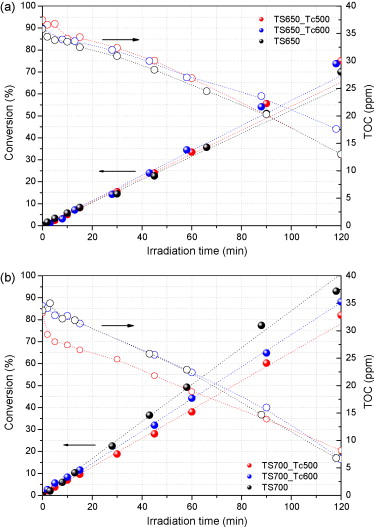
Abstract
TiO2 materials were prepared by sol–gel method and then impregnated with sulfuric acid and calcined using different temperatures and atmosphere (air and nitrogen). Systematic variation of these two experimental parameters makes possible to modulate the amount of surface sulfur from the impregnation procedure. The best photocatalyst for liquid phenol degradation was obtained after calcination at 700 °C in air, while gas toluene degradation optimum performance is obtained by calcination at 700 °C in nitrogen from 500 °C. Structural analysis of these materials by XRD, micro-Raman spectroscopy and FE-SEM shows that once calcined at 700 °C the material was a well-crystallized, high surface area anatase structure in all cases. The surface characterization by FTIR and XPS confirms the presence of a higher amount of sulfur species and acidic OH groups in samples partially calcined in nitrogen, and a low XPS O/Ti-atomic ratio with the O 1s peak shifted to higher binding energies (1.8 vs. 2 ± 0.1 and 530.4 eV vs. 529.8 eV, respectively, against the reference materials) for samples calcined at 700 °C, temperature at which most of sulfate species have been evolved. The paper presents an attempt to correlate the contribution of the observed structural defects within the anatase sub-surface layers and surface acidity to the different photoactivity behaviour exhibited for phenol liquid phase and toluene gas phase photodegradation.
August, 2009 · DOI: 10.1016/j.apcatb.2009.04.026
Materiales de Diseño para la Energía y Medioambiente
Mineralogical stability of phyllosilicates in hyperalkaline fluids: Influence of layer nature, octahedral occupation and presence of tetrahedral Al
Becerro, AI; Mantovani, M; Escudero, AAmerican Mineralogist, 94 (2009) 1187-1197 DOI: 10.2138/am.2009.3164
Abstract
Mineralogical changes in a set of phyllosilicates, differing in their layer nature, chemical composition, octahedral character, and Al content of the tetrahedral sheet, were analyzed after hydrothermal reaction in an alkaline solution. The composition of the alkaline solution was selected to simulate the first stage of cement degradation [NaOH-KOH-Ca(OH)2]. The reaction products have been analyzed by XRD, 29Si and 27Al MAS NMR spectroscopy, SEM/EDX, and TEM. The results indicate that the main factor influencing the stability of the clays is the occupation of the octahedral sheet such that all trioctahedral members withstand the alkaline attack, whereas most of the dioctahedral clays suffer a complete dissolution and crystallization of new phases. Second, clays with Al in the tetrahedral sheet of their layers are shown to be less stable than those with a pure Si tetrahedral sheet.
August, 2009 · DOI: 10.2138/am.2009.3164
Reactividad de Sólidos - Fotocatálisis Heterogénea: Aplicaciones
Kinetics of the thermal decomposition of anhydrous cobalt nitrate by SCRT method
Ortega, A; Macias, M; Gotor, FJJournal of Thermal Analysis and Calorimetry, 98 (2009) 441-448 DOI: 10.1007/s10973-009-0322-y
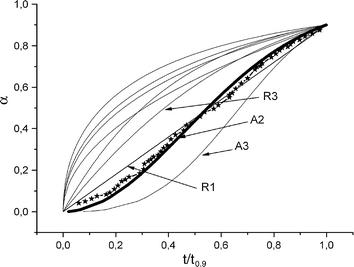
Abstract
It has been shown the ability of the Sample Controlled Reaction Temperature (SCRT) method for both discriminate the kinetic law and calculate the activation energy of the reaction. This thermal decomposition is best described by a Johnson–Mehl–Avrami kinetic model (with n = 2) with an activation energy of nuclei growth which fall in the range 52–59 kJ mol−1. The process is not a single-step because the initial rate of decomposition is likely to be limited by nucleation. The results reported here constitute the first attempt to use the new SCRT method to study the kinetic of the thermal decomposition of cobalt nitrate.
August, 2009 · DOI: 10.1007/s10973-009-0322-y
- ‹ previous
- 34 of 37
- next ›




